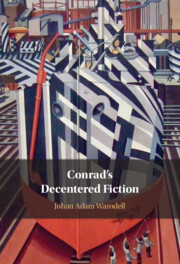Book contents
- Conrad’s Decentered Fiction
- Conrad’s Decentered Fiction
- Copyright page
- Dedication
- Epigraph
- Contents
- Figures
- Acknowledgments
- Abbreviations
- Introduction
- Part I Preprint Documents
- Part II Published Texts
- Part III Patterns and Preoccupations
- Chapter 7 Voices and The Nigger of the ‘Narcissus’
- Chapter 8 Hats, Nostromo, “The Secret Sharer” and The Secret Agent
- Chapter 9 Animals, Heart of Darkness and “The Planter of Malata”
- Conclusion
- Notes
- Bibliography
- Index
Conclusion
from Part III - Patterns and Preoccupations
Published online by Cambridge University Press: 10 March 2022
- Conrad’s Decentered Fiction
- Conrad’s Decentered Fiction
- Copyright page
- Dedication
- Epigraph
- Contents
- Figures
- Acknowledgments
- Abbreviations
- Introduction
- Part I Preprint Documents
- Part II Published Texts
- Part III Patterns and Preoccupations
- Chapter 7 Voices and The Nigger of the ‘Narcissus’
- Chapter 8 Hats, Nostromo, “The Secret Sharer” and The Secret Agent
- Chapter 9 Animals, Heart of Darkness and “The Planter of Malata”
- Conclusion
- Notes
- Bibliography
- Index
Summary
While much focus has been given to historical movements and theoretical concepts, such as colonialism, anarchism and modernism, a complementary focus on the marginal details that uniquely identify Conrad’s texts is needed. In the most extreme search for theoretical abstractions, we have acted like someone who confuses the cookie jar with the cookies – the container with the content – and is terribly offended when caught in the act of chewing on the lid. The details of Conrad’s fiction are, after all, not subservient to larger structures any more than the ontological reason for why cookies exist is so that we can have cookie jars, or any more than the sole reason plants exist is to explain Linnaeus’s taxonomic system (rather than the other way around).
- Type
- Chapter
- Information
- Conrad's Decentered Fiction , pp. 182 - 185Publisher: Cambridge University PressPrint publication year: 2022

